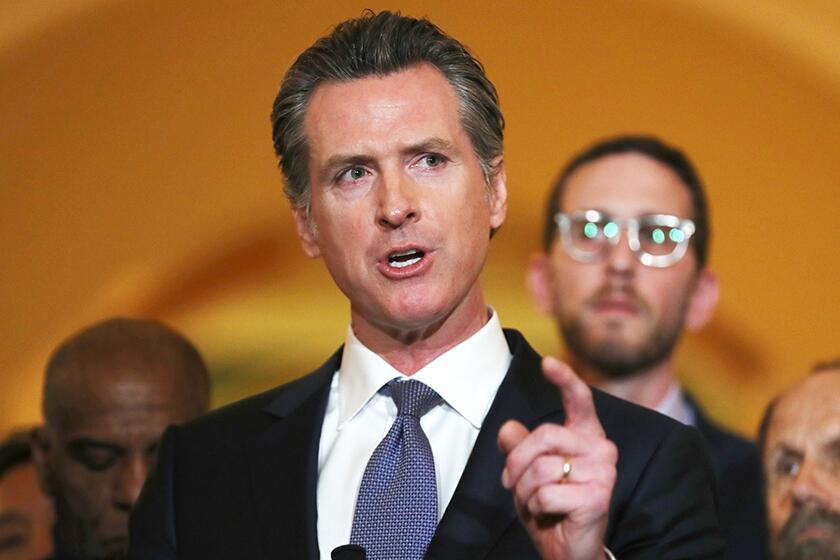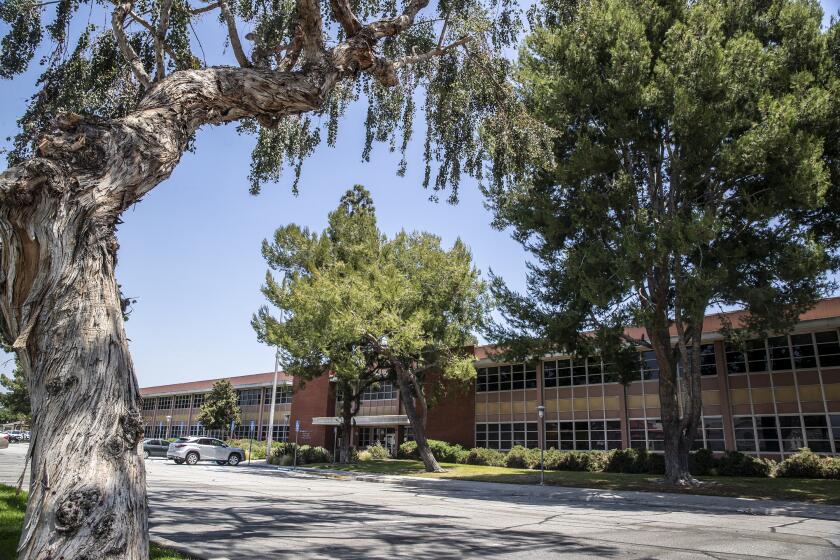Laguna Canyon Road: Big Bend Equals Big Bang
- Share via
‘Something’s got to give.’
--Larry Hunt, auto repair shop owner
On a recent Sunday night, a car slammed into a telephone pole in front of Larry Hunt’s Auto Center at 1825 Laguna Canyon Road.
It wasn’t raining. It wasn’t foggy. Just a another night on the winding, two-lane highway, banked by sweeping hills and cow-dotted pastures that connects Laguna Beach with the San Diego and Santa Ana freeways.
“The guy ends up sitting on the curb” with his face disfigured, Hunt said. “He just didn’t make the turn.”
They call it Big Bend--a turn in the road that gives Hunt a front-row view of some of Orange County’s worst vehicular carnage. It is one of those curves that motorists say just keeps on curving.
Hunt, whose towing business has served Laguna Beach for 33 years, has seen nearly every car accident on Laguna Canyon Road, or, at least, the results of those accidents.
Although the posted speed limit is 35 m.p.h. at the bend, Hunt said he has seen traffic clip by at a steady 55 m.p.h., with some motorists hitting the curve at 90 m.p.h. The latter inevitably lose control and end up smashing into a telephone pole, or worse, into oncoming traffic.
The causes of the accidents vary: drunk drivers, those who fall asleep at the wheel, or impatient motorists who try to pass cars by using the center turning lane.
“It’s the way everybody drives the bloody road. . . . You know, they think they’re on LeMans,” Hunt said.
In the last decade, more than 30 people have been killed in accidents on a 2.3-mile stretch of road--between Canyon Acres Drive and El Toro Road--considered the most dangerous along the eight-mile highway.
The California Department of Transportation, Laguna Beach officials and residents agree that the road needs to be made safer, but they can’t agree on how to do it.
Views Vary Widely
Their differences are philosophical: Caltrans believes the road should conform to the way people drive it. Laguna Beach officials believe drivers should conform to the existing road .
And many Laguna Beach residents fear that a widened, more accessible road will just invite more traffic into their tranquil, seaside village.
Several widening plans for the road have been drafted and scrapped over the years, while mangled cars continue to pile up in Larry Hunt’s garage and lawsuits continue to be filed against Caltrans and the city over the road’s safety.
Caltrans’ current widening plan would require bulldozing and grading part of the adjacent canyon, one of the last pristine coastal-canyon regions in California.
Caltrans officials want to realign the road, straighten some of the curves, increase the number of lanes from two to four and hike the speed limit from 35 m.p.h. to 45 m.p.h. to provide smoother access into and out of Laguna Beach.
The California Coastal Commission, which rejected Caltrans’ first widening proposal in 1986, is expected to review the latest plan in February to see if it meets the commission’s environmental requirements. Commission approval would enable Caltrans to apply for federal funds to help pay for the $14-million project.
Until a month ago, the Laguna Beach City Council had a long-standing policy in support of widening the road. But on Jan. 5, council members unanimously rejected the current proposal, asking instead that Caltrans install safety measures--including a center divider and traffic signals--without widening or realigning the road.
Caltrans will not support road improvements without widening.
Center Dividers Divide
But the talk of center dividers has created yet another faction in Laguna Beach that disagrees with both the City Council and Caltrans.
Several business owners and residents on Laguna Canyon Road are opposed to including a nontraversable center divider because it would make it more difficult to make left and U-turns.
“No one gets into my business in the morning commute because they won’t let you cross,” said Alexander Evans, who owns Dr. Neon, a neon art and sign shop on the road.
“You can wait there for half an hour before they’ll let you out. It’s a sad situation and it’s not getting any better. If they put up barriers, there won’t be any business,” Evans added.
Hunt, of the auto center, also is opposed to a nontraversable barrier, but only from a business standpoint.
“From a lifesaving standpoint, (the median) is important,” he said. “Widening the road is a good idea. It might take out some of the canyon, but not too much. If it saves one life, it’s a good thing.
“Personally, I think the City Council made a mistake by putting their heads down. You cannot have this many persons and this many deaths in this canyon and not do anything about it,” Hunt contended.
Council members say their action has been misunderstood. They are not opposed to making the road safer, but they don’t believe that cutting into the canyon is the best way to do it.
“Somehow, it’s been thought that widening and safety went together, but they’re not necessarily linked that way,” Councilman Neil Fitzpatrick said.
Council members also fear that city traffic would become worse if the road is widened and the speed limit is increased because it would invite more traffic, especially tourists who are unfamiliar with the road.
Said Councilman Robert F. Gentry: “I just can’t see how size and speed will serve the residents of Laguna Beach.”
Traffic Competitors
He said Laguna Beach residents who commute out of their city already are competing with Dana Point and Laguna Niguel residents south of Laguna, who are using Laguna Canyon Road to get to the freeways.
Laguna Beach artist Michael Lavery told the council at a recent meeting that if Caltrans is allowed to widen the road, the city no longer will be known as an art colony, but rather an ant colony, because there will be nowhere for the people to go once they reach the city.
But Caltrans officials argue that the road needs to be widened to accommodate the increasing traffic from nearby growing communities.
“Everyone will drive it at their own special speed,” Ron Kosinski, a Caltrans senior planner, told the City Council during a recent meeting. The proposed road realignment would make it safer for those who insist on driving above the speed limit, he added.
Kosinski said drivers would be able to safely take the proposed Big Bend curve at 60 m.p.h. Those who drive 60 m.p.h. around Big Bend now “have a good chance of having an accident,” he said.
But most of the worst head-on collisions occur in the straight areas of the highway just south of El Toro Road.
Jared Blacketer lives on Sun Valley Road. His property fronts Laguna Canyon Road about half way between Big Bend and El Toro Road.
“I’ve lived there almost 1 1/2 years, and I’ve seen 10 accidents in front of my house. Two fatalities,” he said.
Has Helped Victims
“At 3 or 4 in the morning I’ve heard crash, bang, bam,” said Blacketer, who has run outside in the middle of the night to help crash victims. “I’ve directed traffic, pulled people out of cars.”
He recalled the last fatality he saw, about a year ago: “It was around 4:30 in the morning. Four kids were driving down the road to go surfing when a lady came around the corner in a 280Z at about 95 m.p.h. They hit head-on. One kid died. Another lost two legs. And the other two were in the hospital in stable condition a few days later.”
And the woman?
“She was all right,” he said, shaking his head.
Still, most believe the road needs to be safer for those who abuse it, as well as those who are innocently victimized.
“Something’s got to give,” Hunt said, standing outside his repair business as cars whizzed by.
“This is not progress, this is safety. It’s like putting in lifeguards--you hope nobody drowns. But when you’ve got too much traffic, you know someone’s going to eventually die in an accident.”
LAGUNA CANYON ROAD CHRONOLOGY
February, 1979: Laguna Beach City Council supports widening Laguna Canyon Road from two lanes to four.
December, 1986: Caltrans files widening proposal with California Coastal Commission. Laguna Beach council opposes Caltrans plan but reaffirms its support for widening the road, favoring widening the existing alignment at Big Bend.
December, 1986: Coastal panel rejects Caltrans’ plan, saying it does not meet environmental requirements. Plan called for grading 2.3 million cubic yards of earth to create four-lane highway with median and 50 m.p.h. speed limit.
November, 1987: City staff recommends that the council conceptually approve a Caltrans widening proposal that calls for reducing grading to 530,000 cubic yards and reducing the speed limit to 45 m.p.h. Council rejects the plan but asks Caltrans and city staff to continue working together.
December, 1987: Caltrans submits second widening proposal to Coastal Commission.
January, 1988: Council opposes widening of road. Instead, it asks Caltrans to install median, flashing caution lights and warning signs at Big Bend, and traffic signals at various points on existing road.
February, 1988: Coastal Commission to make decision on second Caltrans widening proposal.
A CLOSE-UP OF THE PROBLEM
Caltrans proposes widening Laguna Canyon Road, where more than 30 motorists have been killed in the last decade, without displaing homes or businesses.
More to Read
Sign up for Essential California
The most important California stories and recommendations in your inbox every morning.
You may occasionally receive promotional content from the Los Angeles Times.










